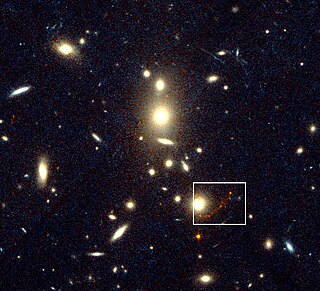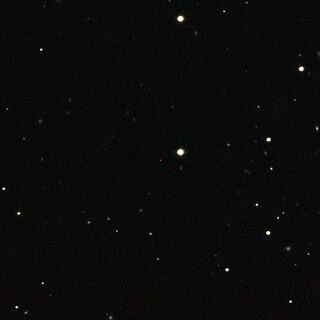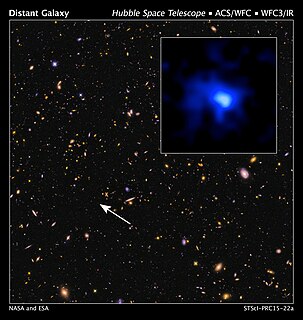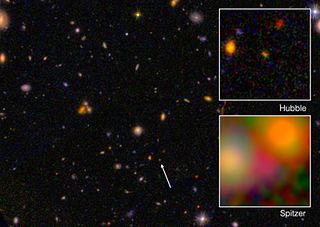
A quasar is an extremely luminous active galactic nucleus (AGN), powered by a supermassive black hole, with mass ranging from millions to tens of billions of solar masses, surrounded by a gaseous accretion disc. Gas in the disc falling towards the black hole heats up because of friction and releases energy in the form of electromagnetic radiation. The radiant energy of quasars is enormous; the most powerful quasars have luminosities thousands of times greater than that of a galaxy such as the Milky Way. Usually, quasars are categorized as a subclass of the more general category of AGN. The redshifts of quasars are of cosmological origin.

The observable universe is a ball-shaped region of the universe comprising all matter that can be observed from Earth or its space-based telescopes and exploratory probes at the present time, because the electromagnetic radiation from these objects has had time to reach the Solar System and Earth since the beginning of the cosmological expansion. There may be 2 trillion galaxies in the observable universe, although that number was reduced in 2021 to only several hundred billion based on data from New Horizons. Assuming the universe is isotropic, the distance to the edge of the observable universe is roughly the same in every direction. That is, the observable universe is a spherical region centered on the observer. Every location in the universe has its own observable universe, which may or may not overlap with the one centered on Earth.

The Hubble Ultra-Deep Field (HUDF) is a deep-field image of a small region of space in the constellation Fornax, containing an estimated 10,000 galaxies. The original data for the image was collected by the Hubble Space Telescope from September 2003 to January 2004. It includes light from galaxies that existed about 13 billion years ago, some 400 to 800 million years after the Big Bang.

An Einstein ring, also known as an Einstein–Chwolson ring or Chwolson ring, is created when light from a galaxy or star passes by a massive object en route to the Earth. Due to gravitational lensing, the light is diverted, making it seem to come from different places. If source, lens, and observer are all in perfect alignment, the light appears as a ring.

Q0906+6930 was the most distant known blazar at the time of its discovery in July, 2004. The engine of the blazar is a supermassive black hole (SMBH) approximately 2 billion times the mass of the Sun. The event horizon volume is on the order of 1,000 times that of the Solar System. It is one of the most massive black holes on record.

CL 1358+62 is a galaxy cluster located at z=0.33 redshift. Behind the cluster, lensed into a red arc is an infant galaxy that was the farthest object in the observable universe for a few months. It had a record redshift of z=4.92 and was discovered on July 31, 1997 by M. Franx and G. Illingsworth. It is located approximately 26 billion light years from Earth. Its redshift was measured by the Keck Telescope shortly after its discovery. Along with G1, another galaxy also lensed, was found to be at z=4.92. The pair of galaxies were the first things other than quasars to have the title of most distant object found, since the 1960s. The pair of galaxies remained the most distant objects known until the discovery of RD1 at z=5.34, the first object to exceed redshift 5.

RD1 or 0140+326 RD1 is a distant galaxy, it once held the title of most distant galaxy known. RD1 was discovered in March 1998, and is at z = 5.34, and was the first object found to exceed redshift 5. It bested the previous recordholders, a pair of galaxies at z=4.92 lensed by the galaxy cluster CL 1358+62. It was the most distant object known to mankind for a few months in 1998, until BR1202-0725 LAE was discovered at z = 5.64.

3C 66A is a blazar located in the constellation Andromeda.

UDFy-38135539 is the Hubble Ultra Deep Field (UDF) identifier for a galaxy which was calculated as of October 2010 to have a light travel time of 13.1 billion years with a present proper distance of around 30 billion light-years.

ULAS J1120+0641 was the most distant known quasar when discovered in 2011, surpassed in 2017 by ULAS J1342+0928. ULAS J1120+0641 was the first quasar discovered beyond a redshift of 7. Its discovery was reported in June 2011.

MACS0647-JD is a galaxy with a redshift of about z = 10.7, equivalent to a light travel distance of 13.26 billion light-years. If the distance estimate is correct, it formed about 427 million years after the Big Bang.

z8_GND_5296 is a dwarf galaxy discovered in October 2013 which has the highest redshift that has been confirmed through the Lyman-alpha emission line of hydrogen, placing it among the oldest and most distant known galaxies at approximately 13.1 billion light-years (4.0 Gpc) from Earth. It is "seen as it was at a time just 700 million years after the Big Bang [...] when the universe was only about 5 percent of its current age of 13.8 billion years". The galaxy is at a redshift of 7.51, and it is a neighbour to what was announced then as the second-most distant galaxy with a redshift of 7.2. The galaxy in its observable timeframe was producing stars at a phenomenal rate, equivalent in mass to about 330 Suns per year.

EGS-zs8-1 is a high-redshift Lyman-break galaxy found at the northern constellation of Boötes. In May 2015, EGS-zs8-1 had the highest spectroscopic redshift of any known galaxy, meaning EGS-zs8-1 was the most distant and the oldest galaxy observed. In July 2015, EGS-zs8-1 was surpassed by EGSY8p7 (EGSY-2008532660).

EGSY8p7 (EGSY-2008532660) is a distant galaxy in the constellation of Boötes, with a spectroscopic redshift of z = 8.68, a light travel distance of 13.2 billion light-years from Earth. Therefore, at an age of 13.2 billion years, it is observed as it existed 570 million years after the Big Bang, which occurred 13.8 billion years ago, using the W. M. Keck Observatory. In July 2015, EGSY8p7 was announced as the oldest and most-distant known object, surpassing the previous record holder, EGS-zs8-1, which was determined in May 2015 as the oldest and most distant object. In March 2016, Pascal Oesch, one of the discoverers of EGSY8p7, announced the discovery of GN-z11, an older and more distant galaxy.

GN-z11 is a high-redshift galaxy found in the constellation Ursa Major. The 2015 discovery was published in a 2016 paper headed by Pascal Oesch and Gabriel Brammer. Up until the discovery of HD1 in 2022, GN-z11 was the oldest and most distant known galaxy yet identified in the observable universe, having a spectroscopic redshift of z = 11.09, which corresponds to a proper distance of approximately 32 billion light-years.

Ton 618 is a hyperluminous, broad-absorption-line, radio-loud quasar and Lyman-alpha blob located near the border of the constellations Canes Venatici and Coma Berenices, with the projected comoving distance of approximately 18.2 billion light-years from Earth. It possesses one of the most massive black holes ever found, with a mass of 66 billion M☉.

HD1 is a purported high-redshift galaxy, and is considered, as of April 2022, to be the earliest and most distant known galaxy yet identified in the observable universe, seen as it was only about 330 million years after the Big Bang 13.8 billion years ago, a light-travel distance of 13.5 billion light-years from Earth, and, due to the expansion of the universe, a present proper distance of 33.4 billion light-years.
















